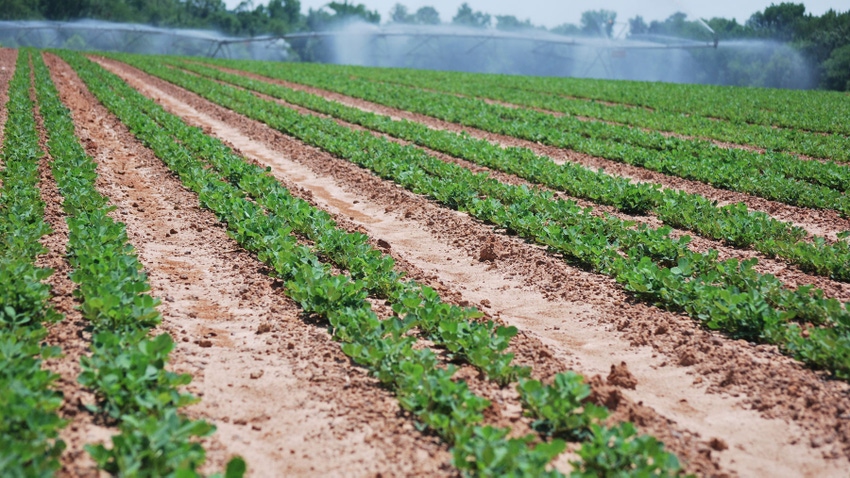
At a Glance
- Acreage, following market queues, has trended down over the last three seasons.
- In 2022, hammered by a surge in tomato spotted wilt virus damage, the average yield fell to 3,855 pounds per acre.
- U.S. peanut farmers plan to plant 1.54 million acres in 2023, or 7% more than 2022.
Marshall Lamb said the U.S. peanut market tale isn’t bad. It’s one peanut that farmers might want to hear.
At the Oklahoma Peanut Expo in late March, the economist and research lead at the USDA National Peanut Laboratory took peanut farmers on a data-driven trip through the domestic peanut market along with some international influences affecting it.
The main takeaway? He said the peanut supply and demand is more reasonably balanced than in the last few years.
But how did the equilibrium arrive and where is it going?
Annually, the U.S. harvested peanut acreage has seesawed over the last decade, jumping from a low of just over a million acres harvested in 2013, to the high of almost 1.8 million acres in 2017.
Acreage, following market queues, has trended down over the last three seasons, he said. In 2020, U.S. farmers harvested 1.61 million acres. In 2022, they harvested 1.41 million acres, or 134,000 acres less than 2021.
Similarly, the U.S. annual average yield has ebbed and flowed. The monster crop of 2012 saw the highest average yield of 4,211 pounds per acre. For the following four seasons, the average dropped annually, bottoming out at 3,634 pounds per acre 2016.
The average yield rebounded in 2017 to 4,007 pounds per acre then slightly declined over each of the next three seasons. In 2021, the average jumped to 4,135 pounds per acre. In 2022, hammered by a surge in tomato spotted wilt virus damage, the average yield fell to 3,855 pounds per acre, or 280 pounds less than 2021.
Remember that drop in 2022 acreage mentioned earlier? That 2022 lower average yield was done on 134,000 fewer acres than 2021, too, which resulted in roughly 2.78 million farmer stock peanuts, or 400,000 tons less production in 2022 than in 2021.
“It is significant in the market when we go down 400,000 tons in a particular year. I hope we break this (yield) trend. We don't want to keep going down. Hopefully we'll break it this year,” he said.
Carryover
The peanut carryover supply, an important market indicator, is trending in the right direction for farmers. The U.S. can manage and shell about 250,000 tons of peanuts each month. The peanut marketing year ends Aug. 1. Between Aug. 1 and around Nov. 1, peanut shellers rely on carryover from the previous year’s crop to keep shelling facilities supplied with peanuts. A 750,000-ton to 800,000-ton carryover is a healthy balanced market.
The 2022 estimated carryover is 984,000 tons. The carryover from the 2018 crop was 1.36 million tons, which tipped the market supply out of balance.
“So, it’s taken us three years to work through that 1.4 million (tons) we got from the 2018/2019 marketing year. And as we’re thinking about this year, we want to produce the best quality and yields, but we really don’t need to overproduce this 2023 crop, either,” he said.
According to the March 31 USDA annual prospective planting survey, U.S. peanut farmers plan to plant 1.54 million acres in 2023, or 7% more than 2022. In Georgia, the largest peanut-producing state, growers indicated they will plant 8% more than in 2022. Acreage is expected to be lower in New Mexico, Oklahoma, and Texas.
In the last two years, U.S. peanut exports have trended around the 500,000-metric-ton mark annually. Exports spiked in 2020. The change was caused by China’s interest in the 2019 crop, which was plagued by weather-related aflatoxin problems, dropping overall crop quality. China likes to buy lower-valued peanuts to crush for its large peanut oil market. When the U.S. produces a higher quality crop, China is priced out, he said.
Per capita
One market indicator that hasn’t fluctuated is domestic peanut demand, which has risen steadily in recent years. Industry-wide cooperation led by the National Peanut Board has driven per capita consumption in the last decade to 8 pounds per person in the U.S. If you include oil consumption that number jumps to just under 10 pounds consumed annually per person.
Overall, right now the 2023 message isn’t a bad one to hear, he said. Yes, production costs will be up like last year, and there is price volatility in competing crops such as for cotton, corn and soybeans. But the supply and demand picture frame for peanuts is balancing better on the wall.
At the end of his talk, Lamb was asked about runner contracts in the Southeast.
“There have been very few contracts offered as of now, and the ones I've heard about the growers are saying, ‘I want to wait and see,’” he said.
This time last year, he said, there were more contracts being offered, but the timing of contract offerings varies from year to year. He didn’t hazard to predict what Southeast runner contracts would be for 2023.
About the Author(s)
You May Also Like






